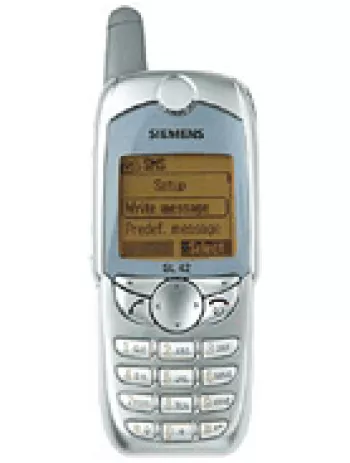
Overview of Siemens SL42
The Siemens SL42 was an innovative mobile device released in 2001, marking a significant contribution to the early 2000s mobile phone landscape. Known for its compact design and cutting-edge features for that time, the SL42 was a favorite among tech enthusiasts and consumers looking for a reliable mobile phone experience.
Design and Build
The Siemens SL42 featured a sleek and compact design, measuring 105 x 46 x 17 mm with a weight of 88 grams. The dimensions made it a highly portable device, easily fitting into pockets and small bags, reflecting the era's preference for smaller, more practical devices. The phone was designed to use a Mini-SIM card and had a robust body that withstood everyday wear and tear effectively.
Display
Equipped with a 1.5-inch monochrome graphic display, the Siemens SL42 offered a basic visual interface capable of displaying 7 lines of text with a resolution of 101 x 80 pixels. While this might seem basic by today's standards, it was sufficient for textual information and basic graphics during its time.
Memory and Storage
The SL42 came with a card slot for MMC, which included a 16 MB card. This allowed for additional storage compared to many contemporaneous phones that relied solely on internal storage. It featured a phonebook capacity to store up to 500 contacts, each with up to 14 fields, showcasing the device's focus on personal information management. Additionally, it maintained records of 10 dialed, received, and missed calls.
Battery Life
The phone was powered by a removable Li-Ion 540 mAh battery, offering up to 200 hours of standby time and up to 4 hours of talk time. For those needing longer battery life, an extended battery option provided up to 350 hours of standby and 7 hours of talk time, making the SL42 a reliable choice for long days on the go.
Communication and Network
The Siemens SL42 was designed to operate on GSM 900/1800 bands, which were common for mobile networks at the time. However, it did not support GPRS or EDGE, which limited its data connectivity to basic calls and text messages. This was a common limitation of early mobile phones before the advent of widespread mobile internet.
Audio and Alerts
The SL42 did not include a loudspeaker or 3.5mm jack, which was typical for phones of its era. It supported monophonic ringtones and vibration alerts, ensuring users could stay notified of calls and messages. The presence of a ringtone composer allowed users to customize their alert tones to a certain extent.
Connectivity Features
Connectivity options for the Siemens SL42 were limited, with no WLAN, Bluetooth, or radio capabilities. It did, however, feature an infrared port, facilitating data exchange with other devices supporting IR communication. Its limitations reflected the technological constraints and usage patterns of the early 2000s, centering around voice and basic text communication.
Interface and Applications
The user interface of the SL42 was straightforward and user-friendly for its time, featuring basic menu navigation suitable for the monochrome display. It came with a few built-in applications including a clock, alarm, and seven simple games. The lack of Java support and advanced applications reflected the primitive nature of phone OS and app ecosystems at that time. The phone supported SMS messaging and included a WAP 1.1 browser, offering a rudimentary web browsing experience.
Additional Features
The SL42 featured several functionalities aimed at enhancing user interaction and accessibility. It supported 20 languages, making it accessible to a broader user base globally. Despite its limited feature set by today's standards, the phone was well-suited to users looking for a simple, robust solution for voice communication and basic text-based tasks.
Conclusion
The Siemens SL42 stood out in its time as a reliable feature phone, offering a balance between essential mobile functionalities and innovative features like expandable storage and personalization options for ringtones. While it was eventually discontinued, its legacy persists as a testament to the evolving journey of mobile phone technology, paving the way for more advanced devices in subsequent years.
Key Features of Siemens SL42
- GSM 900 / 1800 technology support
- Compact dimensions: 105 x 46 x 17 mm, lightweight at 88 g
- Supports Mini-SIM card
- Monochrome graphic display
- Includes 16 MB MMC card for external storage
- Phonebook with capacity for 500 entries with 14 fields each
- Infrared port available
- Supports SMS messaging and WAP 1.1 browser
- Built-in games: 7 available for entertainment
- Multi-language support: 20 languages
- Removable Li-Ion 540 mAh battery with up to 350 hours standby time and up to 7 hours talk time
- Convertible to a slim extended battery for longer usage
Drawbacks of Siemens SL42
- Lacks GPRS and EDGE support which limits internet connectivity and data speeds.
- Discontinued model, so it might be challenging to find support or spare parts.
- Monochrome graphic display with low resolution (101 x 80 pixels) and screen-to-body ratio (~14.6%).
- No camera functionality.
- No loudspeaker and no 3.5mm audio jack for headphones.
- Limited communication features, with no WLAN or Bluetooth support.
- No integrated radio feature.
- Limited SMS-only messaging capability, no support for modern messaging apps.
- Browser is only WAP 1.1, which is outdated for current web standards.
- No support for Java applications, limiting software expandability.
View Also
More Phones
All Rights Reserved +14266 Phones © Mobilawy 2025

























